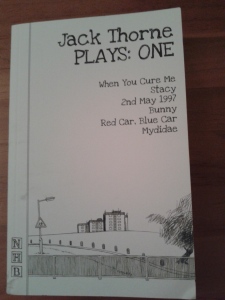“I think I started writing plays as a way of expressing the things I couldn’t say”
This quote from Jack Thorne‘s introduction to his recently published Plays One seems like a good enough reason to start writing plays if you ask me, and one I can personally relate to. My quest to read and see more plays by contemporary writers has started with Thorne who may be more well known for writing for TV, even though he started life as a playwright.
I only managed to read 2 of the plays from this collection this month, but both deal with trauma (a subject I’m quite interested at the moment) and were interesting comparisons: When You Cure Me is a full length piece looking at the affects of rape on a teenage girl over several months and Red Car, Blue Car is a shorter piece commissioned by Bush Theatre that looks at the immediate after affects of a road accident.
I won’t give you a synopsis as you should definitely read these plays for yourself, but here are some things I noticed about his style that I may experiment with in my own work:
- The private made public as show don’t tell & pack a punch at the end
Just by reading his first play (although he admits in the introduction that he wrote about 20 plays before this one was taken up) you can see why Thorne was picked up for TV (Skins pictured is one of his TV series). He does pained adolescent awkwardness and intimacy very well in When You Cure Me and you can imagine it may translate to the small screen even better than it does in theatre. There are some beautiful moments where very intimate, personal actions are made public for the main character and they tell you a lot about the character from the very beginning of the scene before she’s even said anything. A good lesson in show don’t tell that hotlines you into the world of the play. It also engages you emotionally when reading and I imagine this would have been amplified when staged.
These actions didn’t feel that theatrical though (in terms of devices used) but in Red Car, Blue Car Thorne uses the device of 2 characters delivering interconnected but separate monologues to give an unexpected punch at the end when both stories come together. A great theatrical device for helping a short piece stay in the audience’s mind long after it’s left the stage, and it stayed with me far longer than the other piece (though that may tell you something about my taste for punchy pieces rather than longer intimate ones).
- Stage directions -‘Nothing’ gives space
Now I know that sometimes stage directions aren’t written in the original script and are worked through rehearsal and written when the show is first performed, given to the publisher for the printed edition by the writer or even the stage manager. However, the stage directions included in When You Cure Me were really interesting. He uses ‘Pause‘ and ‘Silence‘ as maybe Harold Pinter (pictured) might do, he uses ‘Beat‘ too (which is usual enough) but also ‘Nothing’. In fact one stage direction reads ‘Nothing. A big crowd of it. Nothing. More nothing.‘ which I thought was a genius way of giving both the actors space in the script to really feel what was going on for their character at that moment, and also for the audience to digest what they’ve witnessed. Very clever. And when stage I know it would be full of tension. 🙂
- Well-observed speech
Both pieces were rooted in naturalism/realism and my other take away was how he captured awkwardness between exchanges and embarrassments when dealing with his teen characters. It meant you immediately bought into the characters and their stories.
Another thing Thorne says in his introduction is
“Writing plays was a way of winning the conversation by controlling the conversation”
and reading his dialogue and monologues made me less afraid to use half sentences or misunderstandings as conversation. He used everyday words rather than poetics to build images and situations, especially in the monologues, which was a reminder to me that real poetry in theatre can come from acute observations of the everyday rather anything that sounds like poetry.
So where next?
So I’ve learnt quite a bit from Jack Thorne, and I may start to experiment with this new inspiration in my part of our #TriptychChallenge. I’ve had loads of suggestions about other writers to look at from the Facebook group Playwrighting UK and The Book of Maev blog but February’s playwright is going to be Jennifer Haley as I’m seeing The Nether in the West End next month. It’s had great reviews and I’ll be seeing it and then reading the script (if I can get hold of a copy) so I can compare the text on the page to the production.
I’ll let you know any insights next month. 🙂






